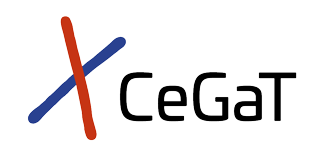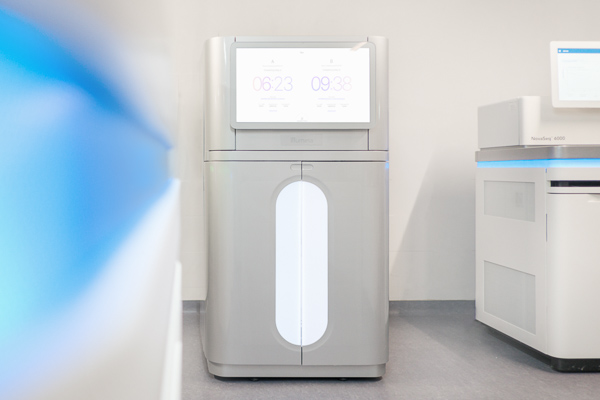The exome represents the entirety of all known coding exons of the human genome. Although exons only comprise 1%–2% of the genome, 89% of all known disease-causing mutations are estimated to be located in these regions. Therefore, it is often reasonable to perform a targeted exome analysis.
Whole exome sequencing can be used for various application areas and goals, such as:
- population genetics
- genetic disorders
- rare diseases
- tumor research
Our Whole Exome Sequencing products provide comprehensive solutions for diverse research questions.
CeGaT Is the Best Partner for Sequencing Your Project
Our Commitment to You
Fast Processing
Turnaround time
≤ 15 business days
High Quality
Highest accuracy for all processes
Secure Delivery
Secure provision of sequenced data via in-house servers
Safe Storage
Safe storage of samples and data after project completion
Our Service
We provide a comprehensive and first-class project support – from selecting the appropriate product to evaluating the data. Each project is supervised by a committed scientist. You will have a contact person throughout the whole project.
Our service includes:
- detailed project consulting
- product selection tailored to your project
- detailed bioinformatic evaluation of your data
- detailed project report with information about sample quality, sequencing parameters, bioinformatic analysis, and results
Benefit from our dedicated support and accredited workflows.
Explore Our Product Portfolio for Exome Sequencing
We offer different Whole Exome Sequencing (WES) products to address a variety of research questions. Would you like to have bioinformatic analyses performed on your data in addition to the included deliverables? Each of our products can be supplemented with further services. We are happy to advise you.
WES Basic | WES Classic | WES Premium | WES Premium Deep | WES Flex |
Species Human | Species | Species | Species | Species |
DNA quality | DNA quality | DNA quality | DNA quality | DNA quality |
Target enrichment | Target enrichment | Target enrichment | Target enrichment | Target enrichment |
Targeted region | Targeted region | Targeted region | Targeted region | Targeted region |
Sequencing platform | Sequencing platform | Sequencing platform | Sequencing platform | Sequencing platform |
Output approximately 50x coverage (depends on the quality of the starting material) | Output approximately 100x coverage (depends on the quality of the starting material) | Output approximately 100x coverage (depends on the quality of the starting material) | Output approximately 150x coverage (depends on the quality of the starting material) | Output |
Included deliverables Project report & files in FASTQ format | Included deliverables Project report & files in FASTQ format | Included deliverables Project report & files in FASTQ format | Included deliverables Project report & files in FASTQ format | Included deliverables Project report & files in FASTQ format |
Our Exome Sequencing products can be combined with our HLA Sequencing products. For tumor samples, please have a look at our Comprehensive Tumor Profiling product portfolio.
Bioinformatics
Raw sequencing data are automatically processed. We offer different levels of bioinformatic analysis. The default level is Level 1. With increasing bioinformatic level, more data are delivered. All higher levels include the data from the lower levels. In addition to the data, and independent of the analysis level, a project report is generated.
All WES products are analyzed with the Illumina DRAGEN Bio-IT Platform. We can perform the analyses for our standard WES products (except WES Flex) based on the human references hg19 or GRCh38.
Level 1:
- demultiplexing and adapter trimming of the sequencing data (FASTQ format)
- metrices (CSV format)
- MultiQC report (HTML format)
Level 2:
- mapping of the sequencing data (BAM format)
- metrices (CSV format)
Level 3:
- calling of single nucleotide variants (SNVs) and small insertions and deletions (indels) (VCF format)
- metrices (CSV format)
Level 4:
- annotation of the SNVs and indels (JSON and TSV format) (only for human samples)
Level 5 (one of the following):
- calling of copy number variations (CNVs) (VCF and GFF3 format) including metrices (CSV format) (only for human samples)
- variant comparison in multiple samples, e.g., trio filtering (VCF and TSV format)
Technical Information
At CeGaT, paired-end sequencing (2 x 100 bp) is performed using the Illumina sequencing platforms. If you require other sequencing parameters, please let us know! We can provide further solutions.
Further Information about Exome Sequencing
Exome sequencing is also known as whole exome sequencing (WES). Using this approach, all protein-coding regions of genes in a genome are sequenced. The aim of whole exome sequencing is the identification of genetic variants in a specific sample. A variation in the protein coding region can, for example, cause diseases, such as multiple endocrine neoplasia type 2B, Huntington’s disease, or Creutzfeldt-Jakob disease. With whole exome sequencing, such disease-causing variants can be identified. Additionally, whole exome sequencing is often used to address a variety of research questions. These research questions and applications include the identification of rare variants that are associated with complex traits, or the advancement of personalized medicine. Another application area of whole exome sequencing is the progression tracking of a therapy success. Thus, whole exome sequencing is a very powerful tool for modern medicine as well as research approaches, clinical trials, and drug development processes.
The exonic regions harbor the majority of genetic alterations causing disease phenotypes – namely large genetic variants, copy number variations (CNVs), small insertions and deletions (indels), single nucleotide polymorphisms (SNPs), and single nucleotide variants (SNVs).
In consequence, researchers are choosing a highly efficient method to answer their research questions by using WES. Additionally, whole exome sequencing is the most cost-effective solution to investigate genetic variations associated with a certain disease.
The technique of whole exome sequencing consists of two steps. Within the first step, the subset of regions that encode proteins, the exons, are captured. The captured targets are then isolated, washed, and eluted. After amplification, these targets are used for the second step – the sequencing of the exomic DNA.
Whole exome sequencing has some advantages in comparison to other technologies that identify genetic variants. In contrast to microarray-based genotyping, whole exome sequencing can be used to identify unexpected genetic changes. By that, whole exome sequencing addresses the previous limitations of microarray-based genotyping. In comparison to whole genome sequencing, whole exome sequencing reveals the huge difference between the exonic and intronic regions: In exome sequencing, only 1%-2% of the whole genome are sequenced, allowing for a higher sequencing depth, and decreasing the sequencing costs.
Downloads
Contact Us
Do you have a question or are you interested in our service? Feel free to contact us. We will take care of your request as soon as possible.
Start Your Project with Us
We are happy to discuss sequencing options and to find a solution specifically tailored to your clinical study or research project.
When getting in contact, please specify sample information including starting material, number of samples, preferred library preparation option, preferred sequencing depth and required bioinformatic analysis level, if possible.






